1. About the AMD 790GX chipset
 The acquisition of ATI Technologies back in 2006 opened the way for AMD to enter the development of new chipset series that integrate powerful graphics. AMD's latest chipset, the 790GX, integrates advanced performance tuning for AMD Phenom processors, plus ATI RadeonTM HD 3300 motherboard graphics processor (mGPU).
The acquisition of ATI Technologies back in 2006 opened the way for AMD to enter the development of new chipset series that integrate powerful graphics. AMD's latest chipset, the 790GX, integrates advanced performance tuning for AMD Phenom processors, plus ATI RadeonTM HD 3300 motherboard graphics processor (mGPU).
Today we will test two motherboards based on the AMD 790GX series, the Gigabyte MA790GP-DS4H and the Foxconn A7DA-S. Both implementations look quite similar in terms of specifications and we are about to see how they perform in real tests and under overclocking. But first, let's say a few words about the the AMD 790GX chipset.
AMD's latest offering is based on the 780G/SB700 chipsets but adds a few improvements. The most noticeable improvement is the clock speed of the IGP that now rumps at 700 MHz, while the SidePort (on board) memory which is GDDR-3 is running at 1333MHz offering an extra 2.6GB/sec bandwidth. In our test samples of this review, the Sideport is 128MB, but generally it can also can be 64MB.

The 790GX series is compatible with the AM2+ socket and supports HT 3.0. The passively cooled chip has been manufactured using the 55nm process. It also requires less power than the 780G series.
Passing to more technical details, it supports 26 PCI-e 2.0 lanes, which are useful for CrossFire. However, the 790GX splits into 2x 8x PCI-e, occupying the 16 lans. A full CrossFire configuration would need at least 32 lanes (for 2x 16x PCI-e setup). While this might not be the fastest solution for CrossFire, it should handle it without problems.

Another improvement is the inclusion of SB750 southbridge chip that adds RAID5 functionality among with ACC (Advanced Clock Calibration). The latest function is useful when overclocking and hopefully helps the overall process, as we will find out later in our review. Last but not least, the AMD 790GX series output VGA, DVI and HDMI interfaces, making it a great add-on for HTC users. For more information about 790GX series, visit ATI/AMD website.
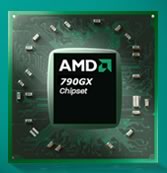
ATI Radeon Graphics Powering
DirectX 10 |
Powered by ATI Radeon Graphics, DirectX10 introduces detail-rich images and dynamic interactivity for playing the latest DirectX 10 games |
| HyperTransport 3.0 Technology |
HyperTransport 3.0 more than doubles your CPU communications bandwidth to graphics as compared to HT1 |
| PCI Express Generation 2.0 |
Double your graphics bandwidth over earlier PCI Express for improved performance |
| Backwards Compatibility |
Ensures flexibility to build platforms with previous generation CPUs as well as the latest AMD Phenom processors |
| Performance Cache |
Performance and power improvements with AMD’s side port technology |
ATI Hybrid Graphics |
Improve your system performance by enabling the ability for both discrete graphics and integrated graphics to render simultaneously |
| ATI CrossFireX Technology |
Upgrade to even greater 3D performance quickly and easily with plug-and-play ATI CrossFireX technology when you use two discrete ATI Radeon Graphics cards |
| ATI Avivo HD2 |
ATI Avivo HD is the advanced image and video processing and display technology found in ATI Radeon graphics that enables:
- brilliant colors, sharp images and smooth playback of Blu-ray and HD DVD content
- performance that rivals high end HD DVD and Blu-ray players on difficult 1080i content
- built-in HDMI and DVI with HDCP
|
| Low Power Design |
Designed for power-efficient computing to help lower energy costs |
| AMD Cool’nQuiet 2.0 |
Benefit from power saving features that help reduce power consumption at idle or during low usage |
| Enhanced Digital Display Integration |
Supports Display Port interface for the latest displays. Includes a TDMS interfacen that enables dual-link DVI or HDMI 1.2 as well as HDCP 1.1 |
| ATI SurroundView |
SurroundView feature allows support for up to four independent monitors for systems equipped with an additional Radeon discrete graphics card |
ATI PowerPlay |
Flexible power saving technologies that ensure optimal power efficiency to help reduce your electricity costs |
| SB750 Southbridge |
Support for up to 12 USB 2.0 connections and 6 SATA 2.0 devices, including eSATA devices. Also includes support for RAID 0, 1, 5 and 10 |
AMD OverDrive with Advanced Clock Calibration |
Shift your system performance into next gear with Advanced Clock Calibration that allows you to get the highest overclocking out of your AMD Phenom CPUs. AMD OverDrive also enables control of the AMD 790GX to easily configure system settings in Microsoft Windows in real-time |
AMD RAIDXpert |
Easily configure your RAID setup from remote locations to personalize your media for extra performance or enhanced reliability. Additional RAID 5 support with SB750 |
2. Gigabyte MA790GP-DS4H
Gigabyte 's proposal for the 790GX platform is the MA790GP-DS4H. The motherboard retails for $129.
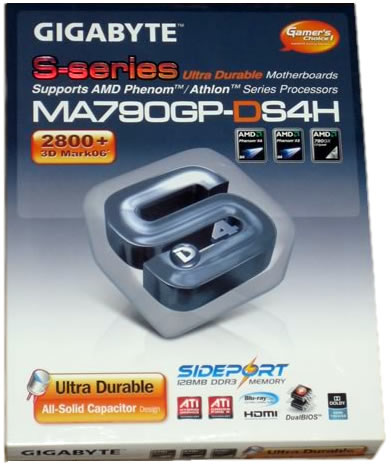
What's extra in Gigabyte product is the all-solid capacitor motherboard design and the DualBIOS Bios protection. To get familiar with all the Gigabyte MA790GP-DS4H features, visit the product's website.
Inside the box everything placed in order:

Here is what you will find in the box:
- A Motherboard driver disc
- A
User's Manual
- A Quick Installation Guide
- One IDE cable and one floppy disk drive cable
- Four SATA 3Gb/s cables
- 2-port USB 2.0 bracket
- I/O Shield
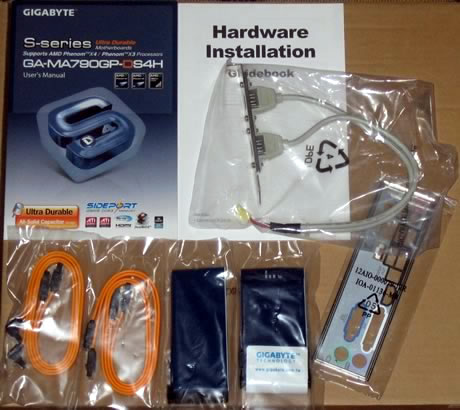
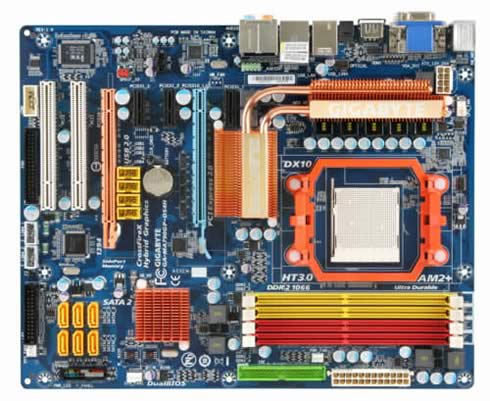
The chipset is covered by a low height copper heatsink. For our tests we used a pretty large cpu cooler (Scyth Mugen). The installation was easy since the heatsinks found in the nearby CPU area are not large.

Four DDR-2 DIMMs are available on the board allowing for up to 8GB memory configurations:
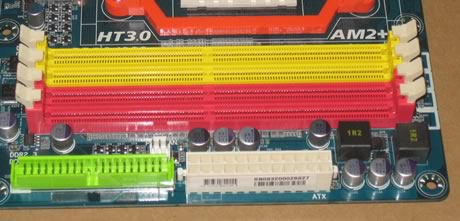
At the left area of the board there are six (6) SATA II connectors, the front panel pins and of course the passive heatsink for the SouthBridge (SB750).

The motherboard includes two (2) PCI-e v2.0 slots. When you install a CrossFire setup, the motherboard will switch to 2x 8x PCI-e mode, resulting to slightly lower speeds than a full 2x 16x PCI-e setup. There is enough space between the PCI-e slots for easier installation of big sized graphic cards.
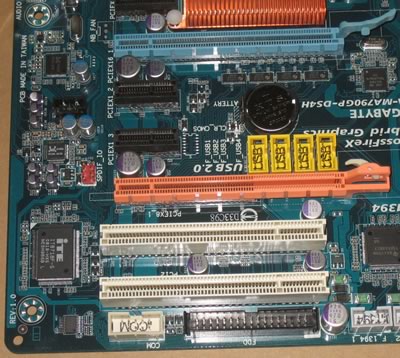
The back I/O panel has the following ports and connectors:
- 1 x PS/2 keyboard port
- 1 x PS/2 mouse port
- 1 x D-Sub port
- 1 x DVI-D port
- 1 x HDMI port
- 1 x optical S/PDIF Out connector
- 1 x IEEE 1394a port
- 4 x USB 2.0/1.1 ports
- 1 x RJ-45 port
- 6 x audio jacks (Center/Subwoofer Speaker Out/Rear)
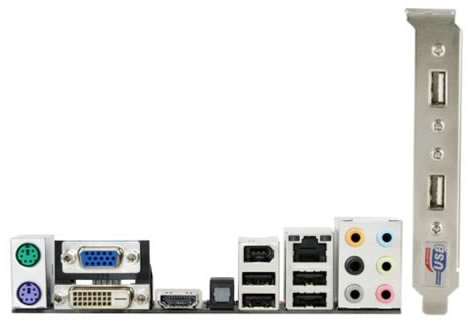
3. BIOS - Gigabyte MA790GP-DS4H
We updated the Gigabyte MA790GP-DS4H motherboard with the latest BIOS (F2A). The majority of the AMD 790GX motherboards are based on the Award Software design:
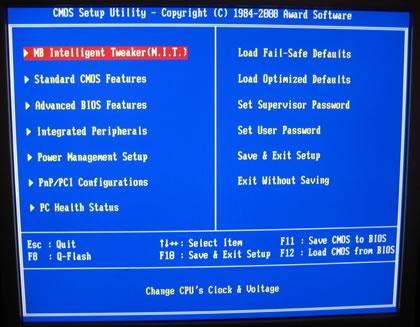
All the main functions are conveniently gathered in the MB Intelligent Tweaker (M.I.T) tab. Here we can adjust the HT Link frequncy, EPP mode (manual/auto), CPU clock ratio and several other things as the following pictures show:
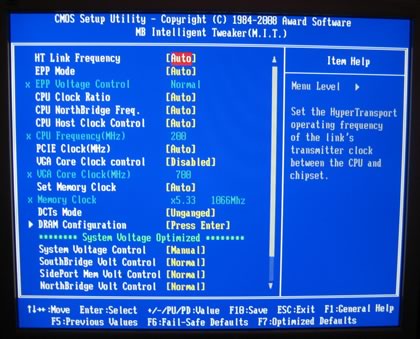
At the voltage area, we can set the voltages as we wish but the the values are in the +X.XXV format. After selecting a value, the motherboard will display the actual value on the right.

- SouthBridge Volt Control: 0.1~0.30V increment
- SidePort Mem Volt Control: 0.1~0.3V at 0.1V increment
- NorthBridge Volt Control:
-0.200~0.300V at 0.025V
- DDR2 Voltage Control: 0.05~0.55V at 0.05V increment.
Getting into the Advanced BIOS features, we can select settings for the onboard graphics card:
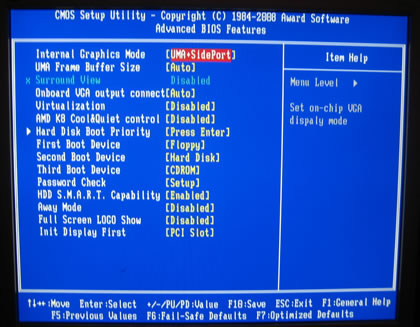
While the PC Health Status offers important information about the voltages and fan speeds

- Test Configuration
We installed the AMD Phenom X4 9950BE PCU on the the Gigabyte motherboard and this is how our processor was identified by CPU-Z:




Note that the motherboard recognized the EPP profile of our DDR2 memory and automatically set the DRAM frequency and voltage.

4. Foxconn A7DA-S
Foxconn has its own proposal for the AMD 790GX platform, the A7DA-S. The motherboard costs around $125 ($109.99 after rebate).

To get familiar with all the Foxconn A7DA-S features, visit the product's website. Inside the retail box you will find:
- A Motherboard driver disc
- A
User's Manual
- A Quick Installation Guide
- One IDE cable and one floppy disk drive cable
- Two SATA 3Gb/s cables
- An e-SATA bracket
- I/O Shield
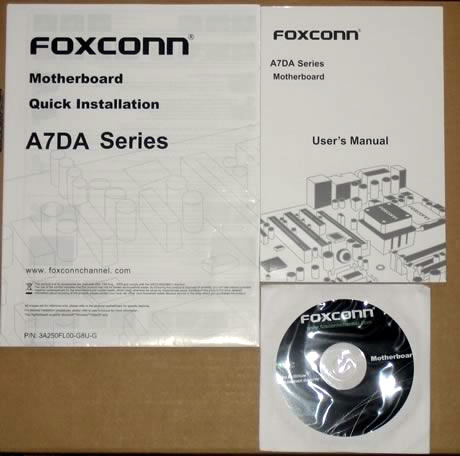

The Gigabyte motherboard included more SATA cables in the retail package but anyway it is not that important if you ask me. The board itself looks very "clean" as most parts can be identified
easily. Comparing the two motherboards, we see that the Foxconn A7DA-S is larger in physical dimensions than the Gigabyte MA790GP-DS4H.
We can also see that the Foxconn has added a power jack on the board, probably to support CrossFire setups more efficiently. The floppy port on the Foxconn board is placed is above the ATA, while at the Gigabyte has moved it to another area. Foxconn had included two buttons at the lower left area (power/reset) that makes our life much easier. In addition, the SATA ports at the Foxconn have different orientation than the Gigabyte's board.


The CPU area is not very crowded and our Scyth Mugen CPU cooler fit without any problems.

Four DDR-2 DIMMs are available properly colored for dual-channel installations:


The motherboard includes two (2) PCI-e v2.0 slots. When you install a CrossFire setup, the motherboard will switch to 2x 8x PCI-e mode as we previously described with the Gigabyte board.

The back I/O panel has the following ports and connectors:
- 1 x PS/2 keyboard port
- 1 x PS/2 mouse port
1 x DVI-D port
- 1 x HDMI port
- 1 x VGA port
- 1 x 1394a port
- 4 x USB 2.0 ports
- 1 x RJ-45 LAN port
- 8 channel Audio ports

5. BIOS - Foxconn A7DA-S
We updated the motherboard with the latest BIOS (P05). The BIOS is slightly different than what we saw with the Gigabyte's solution. This one is not as straightforward as Gigabyte's, in our opinion.
The general tab has various sub-categories:

Entering at the Fox Central Control Unit, we can adjust all the major functions of the motherboard.

However, unlike Gigabyte's solution, all the functions are placed in several sub-categories so you have to go up&down in order to find what you are looking for and make any change.
The SmartBIOS provides some information about the cpu/memory:

At the Fox Intelligent Stepping we find the FSB, memory speed, Gfx and CPU multiplier:

The memory can be set to 200, 266, 333, 400 and 533MHz
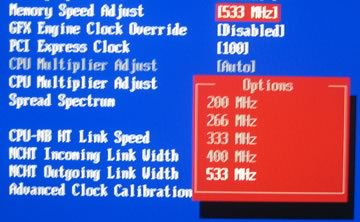
Overclocking the ATI HD3300 is also possible.
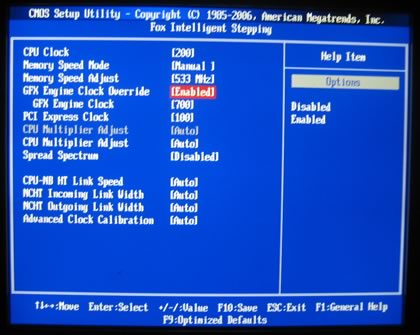
Under the other menu called Voltage Options, we can set the CPU, memory, NB and HT/SB voltages. Again the numbers are relative to the selected value, meaning that you have to guess what the initial value was.




Under the CPU configuration we find more options such as enable/disable Cool'N'Quiet, C1E support and TLB Patch (for processors who need it).
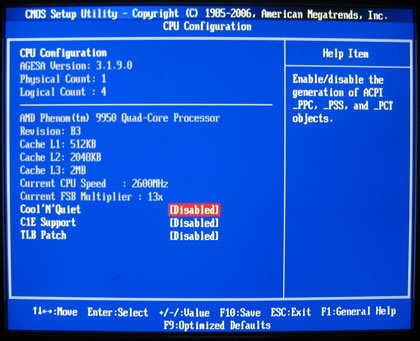
Under the Advanced chipset features, you can configure the memory timings and the IGP settings
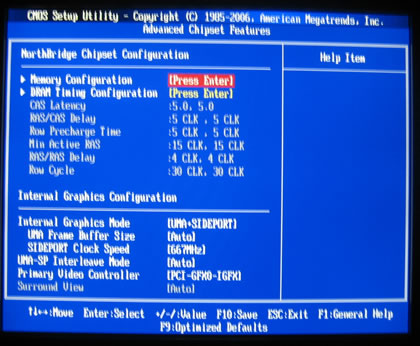


The last BIOS tab we have to mention is the PC Health status that offers important information about the motherboard and the cpu:

- Test Configuration
We installed the AMD Phenom X4 9950BE on the Foxconn motherboard

Unlike to the Gigabyte motherboard, the Foxconn board does not support EPP profiles. Therefore, we had to manually force the motherboard to work at 533MHz.

6. Tests Setup
Below you can see our test PC configuration for all the tests:
- CPU: AMD Phenom X4 9950BE
- CPU Cooler: Scythe Mugen (with two 120mm fan)
- Memory: 2x1GB OCZ PC2-8500SLI @ 1067Mhz (5-5-5-15-2T@2.30V Unganged)
- VGA: MSI 7600GT Silent
- HDD1: WD 800JB 80GB 7200rpm
- HDD2: WD 800JB 80GB 7200rpm
- Windows XP SP2 with all the latest updates
- Windows VISTA SP1 with all the latest updates
- DirectX10 Sept2008 updated
Our testbed includes several benchmarks, real life applications under both Windows XP and VISTA:
Windows XP
- Everest Ultimate Edition
- Sisoft Sandra
- wPrime
- x264Benchmark
- SuperPI
- SysMark 2007 Preview
- CineBench
- TMPGEnc
Windows VISTA
- PCMark Vantage
- 3DMark 06
- Crysis Retail
- Unreal Tournament Demo
Just before we start throwing the test results, let' s try to answer to some questions regarding the Ganged vs Unganged modes of testing. So what is their differences and which one should we use?
Ganged refers to the use of both DRAM controllers within a memory controller acting in concert
to access memory. Below is a description of ganged (128-bit DRAM data width) and unganged (64-bit DRAM data width) DRAM modes:
Ganged channels
- DCT channels A and B can be ganged as a single logical 128-bit DIMM
- Offers highest DDR2 bandwidth
- Requires both DIMMs in a logical pair to have identical size and timing parameters, both DCTs programmed identically.
Unganged channels
- DCT channels A and B operate as two completely independent 64-bit channels (both channels
operate at the same frequency).
- Reduce DRAM page conflicts – more concurrent open dram pages
- Better bus efficiency.
In theory, both modes has their own negative and positive points. However, which one is d faster? We have done some quick tests for you:
SuperPI v1.5XS Mod |
32Million (mins) |
16Million (mins) |
8Million (mins) |
4Million (mins) |
2Million (mins) |
1Million (min) |
| Unganged |
28,18245 |
12,54188 |
5,44954 |
2,37281 |
1,10344 |
0,29891 |
| Ganged |
28,25141 |
12,54797 |
5,45594 |
2,37765 |
1,10609 |
0,29969 |
At the SuperPI calculation, the Unganged mode was faster.
| Everest Ultimate |
Memory Read |
Memory Write |
Memory Copy |
| Unganged |
7773 |
5030 |
8645 |
| Ganged |
8112 |
5052 |
8560 |
Proceeding to the Everest Ultimate, we can see that the Ganged mode gave better Memory read/write performance but lower Memory copy results. In addition, the wPrime95 32M benchmark is better under the Unganged mode. All of our tests results were performed in the Unganged mode.
| wPrime v1.55 32M |
Calculation Time (Sec) |
| Unganged |
15,453 |
| Ganged |
15,468 |
7. Benchmarks - Everest Ultimate Edition, SiSoftware Sandra
- Everest Ultimate Edition
 EVEREST Ultimate Edition is a system diagnostics and benchmarking solution for enthusiasts PC users, based on the EVEREST Technology.
EVEREST Ultimate Edition is a system diagnostics and benchmarking solution for enthusiasts PC users, based on the EVEREST Technology.
During system optimizations and tweaking it provides essential system and overclock information, advanced hardware monitoring and diagnostics capabilities to check the effects of the applied settings. CPU, FPU and memory benchmarks are available to measure the actual system performance and compare it to previous states or other systems. Furthermore, complete software, operating system and security information makes EVEREST Ultimate Edition a comprehensive system diagnostics tool. The software also includes several tests for memory and CPU/FPU.

Both motherboards had a good performance at the Memory tests, with the Gigabyte to have a small advantage, probably due to the support for EPP profiles.

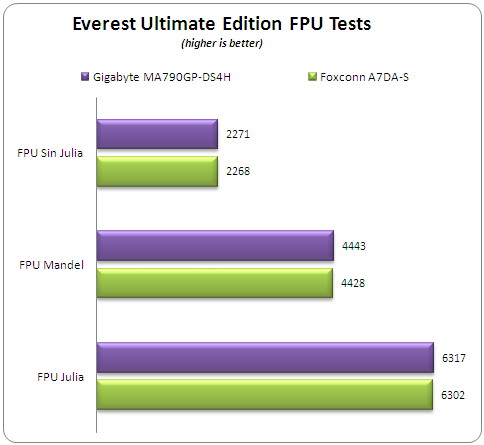
The Gigabyte MA790GP-DS4H seems to be slightly faster than the Foxconn A7DA-S at the CPU tests. Let's see what Sisoft Sandra software has to say about this..
 SiSoftware Sandra (the System ANalyser, Diagnostic and Reporting Assistant) is an information & diagnostic utility. It should provide most of the information you need to know about your hardware, software and other devices whether hardware or software. It works along the lines of other Windows utilities, however it tries to go beyond them and show you more of what's really going on. You can get information about the CPU, chipset, video adapter, ports, printers, sound card, memory, network, Windows internals, AGP, PCI, PCIe, ODBC Connections, USB2, 1394/Firewire, etc. Sisoft Sandra offers a variety of tests for Memory and CPU.
SiSoftware Sandra (the System ANalyser, Diagnostic and Reporting Assistant) is an information & diagnostic utility. It should provide most of the information you need to know about your hardware, software and other devices whether hardware or software. It works along the lines of other Windows utilities, however it tries to go beyond them and show you more of what's really going on. You can get information about the CPU, chipset, video adapter, ports, printers, sound card, memory, network, Windows internals, AGP, PCI, PCIe, ODBC Connections, USB2, 1394/Firewire, etc. Sisoft Sandra offers a variety of tests for Memory and CPU.


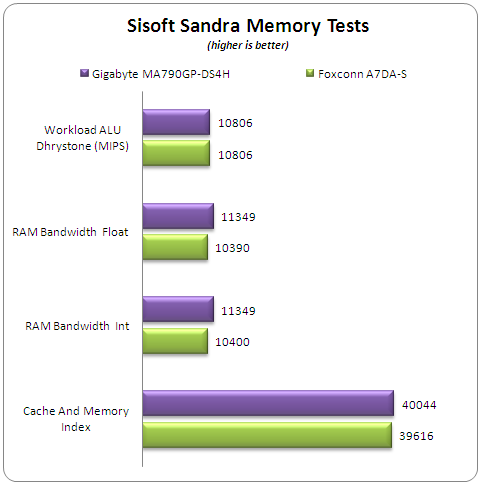
The Sisoft Sandra results confirmed partially that the Gigabyte MA790GP-DS4H was somewhat faster than the Foxconn A7DA-S, especially in the memory tests. That should explain the small differences (in favor) in the previous benchmarks.
8. Benchmarks - PCMark Vantage, SYSmark 2007 Preview
 PCMark Vantage is the first objective hardware performance benchmark for PCs running 32 and 64 bit versions of Microsoft Windows Vista. The software is suited for benchmarking any type of Microsoft Windows Vista PC from multimedia home entertainment systems and laptops to dedicated workstations and hi-end gaming rigs. Regardless of whether the benchmarker is an artist or an IT Professional, PCMark Vantage shows the user where their system soars or falls flat, and how to get the most performance possible out of their hardware.
PCMark Vantage is the first objective hardware performance benchmark for PCs running 32 and 64 bit versions of Microsoft Windows Vista. The software is suited for benchmarking any type of Microsoft Windows Vista PC from multimedia home entertainment systems and laptops to dedicated workstations and hi-end gaming rigs. Regardless of whether the benchmarker is an artist or an IT Professional, PCMark Vantage shows the user where their system soars or falls flat, and how to get the most performance possible out of their hardware.

The Foxconn A7DA-S board was faster and got a higher overall PCMark score.

BAPCo's SYSmark 2007 Preview builds upon its predecessors and is the next generation of benchmark utilities that utilize real life applications like: Adobe After Effects 7, Adobe Illustrator CS2, Adobe Photoshop CS2, AutoDesk 3ds Max 8, Macromedia Flash 8, Microsoft Excel 2003, Microsoft Outlook 2003, Microsoft PowerPoint 2003, Microsoft Word 2003, Microsoft Project 2003, Microsoft Windows Media Encoder 9 series, Sony Vegas 7, SketchUp 5 and WinZip 10.0.
SYSmark 2007 Preview is an application-based benchmark that reflects usage patterns of business users in the areas of Video creation, E-learning
, 3D Modeling and Office Productivity.
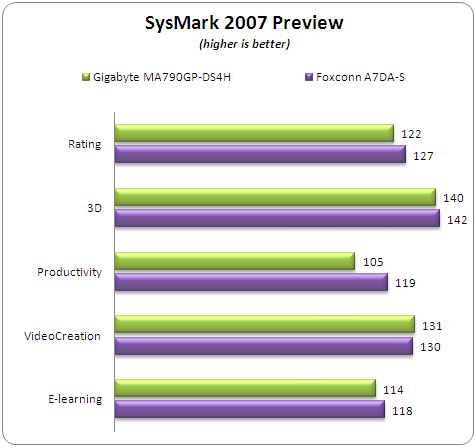
As it happened in the the PCMark Vantage benchmark, the Foxconn motherboard got a higher overall score.
9. Benchmarks - MAXON CINEBENCH, x264 HD Benchmark, TMPGEnc 4 Xpress
 MAXON CINEBENCH is based on MAXON's animation software, CINEMA 4D, which is used extensively by studios and production houses worldwide for 3D content creation.
MAXON CINEBENCH is based on MAXON's animation software, CINEMA 4D, which is used extensively by studios and production houses worldwide for 3D content creation.
MAXON software has been used in blockbuster movies such and Spider-Man, Star Wars, The Chronicles of Narnia and many more. The software runs several tests on your computer to measure the performance of the main processor and the graphics card under real world circumstances. The benchmark application makes use of up to 16 CPUs or CPU cores and is available for Windows (32-bit and 64-Bit) and Macintosh (PPC and Intel-based). The resulting values among different operating systems are 100% comparable.

The motherboards behaved similarly here with the Gigabyte MA790GP-DS4H to have a small lead.
- x264 HD Benchmark
x264 Benchmark utilizes the next generation of Video Encoding benchmarks with support for x264 codec that is considered to be one of the most demanding for Video applications. Simply put, it is a reproducible measure of fast your machine can encode a short, HD video clip to a high quality x264 video file. It's nice because everyone running it will use the identical video clip and software. The video encoder (x264.exe) reports a fairly accurate internal benchmark (frames per second) for each pass of the video encode and it also uses multi-core processors very efficiently. All these factors make this an ideal benchmark to compare different processors and systems to each other.
The benchmark procedure is very simple. You should ran a batch file that encodes the same file four times. The sotware provides the results for both the single pass and the second pass of encoding. The average performance for each processor is available in the graph below:

At both passes, the Gigabyte motherboard proved to be slightly faster.
- TMPGEnc 4 Xpress
TMPGEnc converts *.AVI files to MPEG1, the format which is used in VideoCDs. The application takes advantage of all the CPU resources and actually the encoding time automatically gets faster as CPU speed gets faster.
For our test we encoded a 350MB AVI file with the Xvid (Mpeg4 ASP) codec using the the built- in Mpeg4 ASP/AVC MediaEncoder profile. The average FPS encoding speed for each processor are available below:
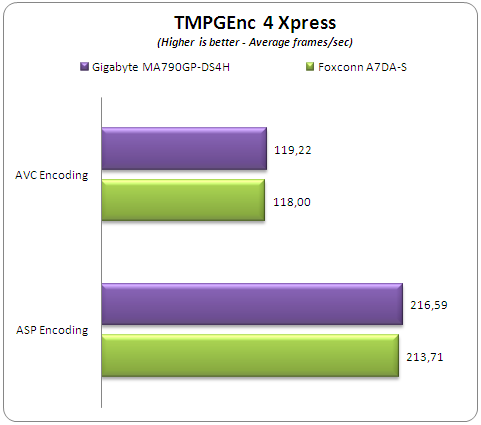
10. Benchmarks - SuperPI, wPrime
SuperPI calculates the pi number. The software was written by D.Takahashi and it was used for the successful the calculation of the pi up to 4,294,960,000 decimal digits in the university of Tokyo in 2005. This record-breaking program was also ported to personal computerenvironment such as Windows and it has become an utility to benchmark modern systems.

The software offers up to 32M calculations of PI numbers. For all our CPUs we tested up to 8M calculations:

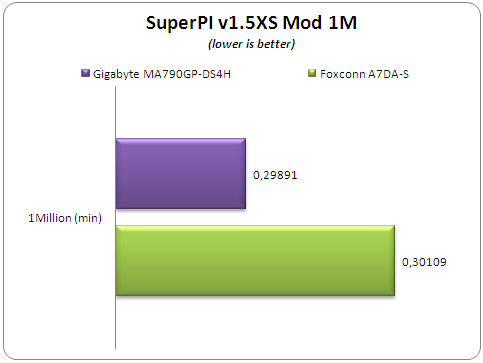
In both benchmarks, we see that the Gigabyte MA790GP-DS4H was faster than the Foxconn A7DA-S. Again, the differences are minor.
- wPrime
wPrime is a benchmarking application designed to use a highly multithreaded approach to calculating the square-roots of large amounts of numbers (up to 32 billion at this stage!)


Both motherboards gave exactly the same performance at the wPrime benchmark.
11. Benchmarks - 3DMark06, Crysis v1.2, Unreal Tournament 3 SYSmark 2007 Preview
 3DMark 06 is the worldwide standard in advanced 3D game performance benchmarking. The software uses advanced real-time 3D game workloads to measure PC performance using a suite of DirectX 9 3D graphics tests, CPU tests, and 3D feature tests. 3DMark06 tests include all new HDR/SM3.0 graphics tests, SM2.0 graphics tests, AI and physics driven single and multiple cores or processor CPU tests and a collection of comprehensive feature tests.
3DMark 06 is the worldwide standard in advanced 3D game performance benchmarking. The software uses advanced real-time 3D game workloads to measure PC performance using a suite of DirectX 9 3D graphics tests, CPU tests, and 3D feature tests. 3DMark06 tests include all new HDR/SM3.0 graphics tests, SM2.0 graphics tests, AI and physics driven single and multiple cores or processor CPU tests and a collection of comprehensive feature tests.

The Gigabyte MA790GP-DS4H got a higher score at the CPU but it fell behind in the overall score.
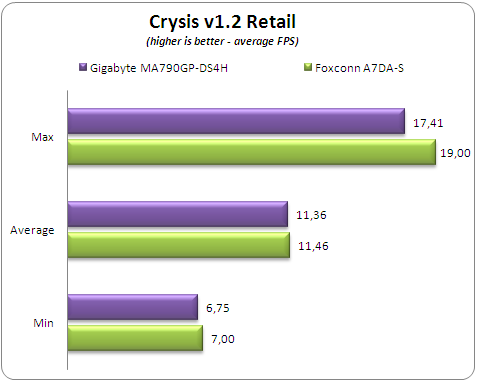
At both the Crysis/Unreal Tournament 3 Demo benchmarks, the performance differences were very small.

12. Overclocking
Both motherboards are supposed to deliver good overclocking levels since they are based on the AMD 790GX platform. The Foxconn motherboards offer the "Foxconn one" software for overclocking under Windows. Although the software works well ,it doesn't offer much control over tweaking. For example, you cannot change the CPU multiplier under Windows, so you have to go under BIOS via a reboot procedure. The same applies to the Gigabyte motherboard with the EasyTune 6 software. Things here are less complicated; we have a better interface but again a few tweaking options. Fortunately for us, AMD has introduced an overclocking/tweaking software called "AMD Overdrive" that can be used for all AMD-based motherboards.
After launching the AMD Overdrive, we got a message warned us that overclocking might damage our hardware. No worries here, just press "OK" and continue:-).
The software's overall layout is very good and each tab has its own purpose. For example in the "system information" we can get info about our (sub)system, the status monitor reports temperatures and voltages while in the Performance control we can set all the major functions.
The Performance control has several other sub-tabs, such as the Clock/Voltage, Memory, Performance, Stability Test and Auto Clock.
First of all, enable the Advanced Clock Calibration, which was disabled by default. In our case we left it at "Auto".

Click to Enlarge!
The first problem we encountered was when we tried to set the CPU voltage. With the Gigabyte MA790GP-DS4H, you cannot set the Vcore under Windows, either with AMD Overdrive or Gigabyte's EasyTune 6 software. That was a little frustrating. So back to the BIOS and after setting Vcore around 1.45V we loaded Windows.
Let's launch AMD Overdrive and try to make some quick tests. Since our processor had its CPU multiplier unlocked, we simply dragged the CPU multiplier slider up until we find a stable point (via Prime95 software). The Gigabyte MA790GP-DS4H easily reached the 3.10GHz without any other tweaking.

Click To Enlarge!
On the other hand, the Foxconn A7DA-S showed a slightly different behavior. Here we could set the Vcore via the AMD Overdrive. We also noticed that the Memory voltage set under BIOS (2.30V) were different that what the AMD Overdrive software set (2.40V). Anyway we set the Vcore at 1.45V and we continued with the same procedure. The Foxconn A7DA-S had a lower performance and our CPU reached the 2.90GHz. We believe that Foxconn could improve the overall performance/compatibility with the AMD Overdrive software.

Click To Enlarge!
The Foxconn FoxOne software also offers "Auto overclock" tests, which allow you to set the the maximum FSB in case you decide to overclock without changing the CPU multiplier. With the default 13X multiplier, we got a 240MHz (~3.120GHz)
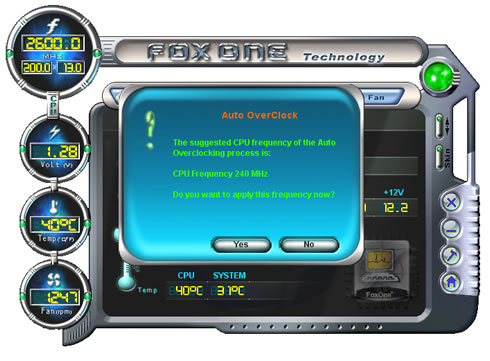
While with the 14X multiplier, we got a 222MHz (~3.108GHz).
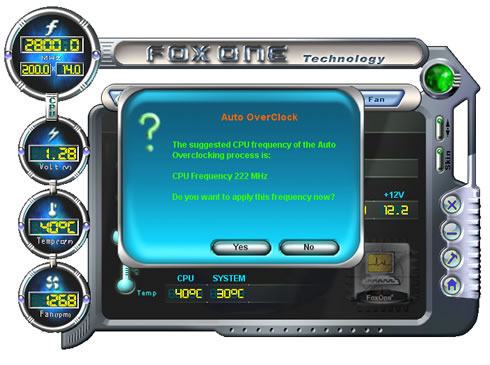
We should note here that the results depend on your processor and the Vcore value. For example, the Foxconn motherboard reached the 3.10GHz but it wasn't very stable, even with the Vcore set at 1.50V. We assume that a more efficient cooling system here could help reduce the overall produced heat and improve stability.
Here are some heat numbers we got with the Scyth Mugen cpu cooler at various speeds:
- 2.90ghz (200x14.5x) 50 Celsius 1.46V
- 3.00ghz (200x15x) 54 Celsius 1.46V
- 3.10ghz (200x15.5x) 62 Celsius 1.504V
For sure both motherboards are ready to be explored via the AMD Overdrive software.
- Overclocking stability
Both motherboards showed more-or-less the same overclocking stability. After serious overclocking attempts, the system was able to post back and report a failed overclocking. In rare cases, we had to use a jumper and clear CMOS in order to get a working POST message.
13. The ATI 3300 IGP
The AMD 790GX platform includes the ATI3300 IGP chipset that promises good performance in all cases, either when you play games or enjoy video playback. Since the tested motherboards are identical at this point, what you will read below applies to both.
We removed the MSI 7600GT Silent card from out test PC and connected the VGA cable to the motherboard. All tests were performed with the ATI Catalyst 8.9 installed.

The ATI Catalyst panel gives us more information about the HD3300 series

As we can see the 55nm ATI HD3300 series have 40 unified Shaders, support DirectX10 and have a 32bit bus width.
We left the memory size at "Auto" under Windows. Both motherboards have 128MB on board. In case memory requirements exceed that point, the graphics engine will use system resources from the system.

We try to test the ATI HD3300 under both gaming and Video playback. For all the gaming tests, we used the following settings at the ATI Catalyst 8.9 control panel:

14. ATI 3300 - Gaming results
We used a variety of 3D Benchmarks as well as games. All the tests were done under Windows VISTA 32bit SP1.
First, let's see how the ATI HD3300 performs in the 3DMark software. The Gigabyte MA790GP-DS4H promises to offer 2800+ points at the specific benchmark. Well, this could be true only if you use the resolution of 1024x768...
In the the native resolution of 1280x1024, the ATI HD3300 scored 2203 points. Passing to the more demanding 3DMark Vantage ,we got 3062 points at 1024x768, while the 1280x1024 test failed to complete, since the frames/second were almost down to zero. That's an indication that the IGP limits gaming at 1024x768.
| 3DMark 05 (1024x768) |
4721 |
| 3DMark 06 (1024x768) |
2844 |
| 3DMark 06 (1280x1024) |
2203 |
| 3DMark Vantage (1024x768) |
3062 |
| 3DMark Vantage (1280x1024) |
Not completed |
Let's now pass to real life games and the question that you have probably in your mind...will this play Crysis or not? The answer is YES but under specific visual quality modes, as the following table shows.
We used the Crysis Benchmark Tool and set a variety of resolutions and image quality options. The Crysis game title should be very playable in case you are using 800x600xLow settings. The average performance was around 48FPS. Increasing the resolution has an affect on the overall performance. At 1024x768xLow the FPS dropped to 35FPS, while at 1280x1024xLow we got the low score of 24FPS (average). Increasing visual quality also resulted to a drop of 27FPS after moving from 800x600xLow to 800x600xMedium..
Crysis (DX9) v1.2.1 |
Average |
| 800x600xLow |
48,89 |
| 800x600xMedium |
21,21 |
| 800x600xHigh |
11,10 |
| 1024x768xLow |
35,66 |
| 1024x768xMedium |
15,77 |
| 1280x1024xLow |
24,22 |
| 1280x1024xMedium |
9,75 |
Passing to the latest Crysis WarHead game title we have more test results that should confirm the above findings. The 800x600 resolution under the "Performance mode" is much playable. After that point, the FPS drop as the resolution/rendering level increase.
| Crysis WarHead (DX9) |
640x480 |
800x600 |
1024x768 |
| Performance |
56,50 |
42,93 |
29,68 |
| Mainstream |
24,64 |
18,63 |
12,84 |
| Gamer |
11,28 |
8,85 |
6,43 |
| Enthusiast |
7,63 |
5,85 |
5,61 |
In the DirectX10 mode we see an even lower performance.
| Crysis WarHead (DX10) |
640x480 |
800x600 |
1024x768 |
| Performance |
42,94 |
33,86 |
23,88 |
| Mainstream |
18,26 |
14,02 |
9,88 |
| Gamer |
8,43 |
6,65 |
4,88 |
| Enthusiast |
5,82 |
4,57 |
3,21 |
Other less demanding DX9 games like Company Of Heroes are playable at 1024x768 with 36FPS after using the following visual settings:

The HL2 Episode 2 can also be played at 1024x768 as soon as you make some changes in the visual quality:
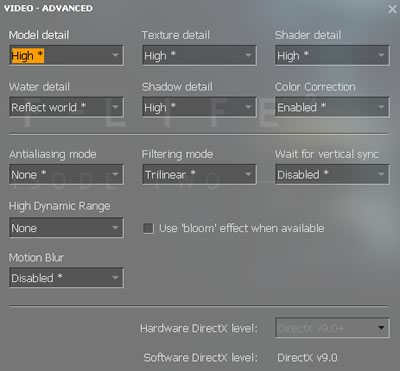
Summing up the above results, we can say that the ATI HD3300 can be used for games - even for 3D Person shooter games - provided that you will set the visual improvements low and adjust the game to a proper screen resolution ...Again I was surprised to see that an IGP can play Crysis even at 800x600 :-)
We still haven't forgotten the overclocking tests. With the AMD Overdrive we were able to push GPU core at 847MHz and the memory at 850MHz!

Click To Enlarge!

Without making any voltage adjustments, the system was stable enough to perform a nine (9) round at Crysis. Let's see whether the increased core and memory clocks had an actual affect in the performance:
| Crysis v1.2.1 (DX9) |
Normal |
Overclocked |
% Gain |
| 800x600xLow |
48,89 |
56,20 |
14,95 |
| 800x600xMedium |
21,21 |
23,81 |
12,26 |
| 800x600xHigh |
11,10 |
12,21 |
10,05 |
| 1024x768xLow |
35,66 |
41,07 |
15,17 |
| 1024x768xMedium |
15,77 |
17,02 |
7,93 |
| 1280x1024xLow |
24,22 |
27,73 |
14,49 |
| 1280x1024xMedium |
9,75 |
11,46 |
17,54 |
It seems that overclocking will help you get higher frame/second at Crysis. While it's not a big difference, you will gain up to 8FPS at 800x600xLow and 6FPS at 1024x768xLow. When the rendering quality improves, the gain is as low as 2~3 FPS.
15. ATI 3300 - Video Playback tests
Here we performed a series of Video playback tests. We used an HDMI cable and connected the motherboard to an LG L246WH (24") TFT/LCD monitor. For all the playback tests we used the PowerDVD 8 Ultra v8.0.2021.50 software with the following settings:

The PowerDVD software automatically recognized the processor/IGP features and enabled Video acceleration playback.

First we used the HQV Benchmark DVD that is used from many companies to evaluate the visual quality of a graphic card/DVD player. Hopefully ATI has done good work and the results are very good:
HQV Visual Tests with PowerDVD 8 Best Quality Mode |
Visual Test |
Score |
| Color Bar / Vertical Detail |
10 |
| Jaggies Patern 1 |
10 |
| Jaggies Patern 2 |
3 |
| Flag |
10 |
| Picture Detail |
10 |
| Noise Reduction |
10 |
| Motion Adaptive |
5 |
| 3:2 Detection |
10 |
| Film Cadence |
25 |
| Mixed 3:2 Film H |
10 |
| Mixed 3:2 Film V |
10 |
Overall Score |
113 |
A perfect overall score for this series of tests would be the 130. The ATI HD3300 scored an 113. The two sub-tests where the IGP gave a lower score was the e "Jaggies Patern 2" and the "the Film Cadance". In the first case the third bar of the test was displayed rather blurred and with some jaggies. The Film Cadance subtest also showed some jaggies on the screen. Thought in real life you will not notice these problems, we consider this performance as a very good one.
Passing to Blu-Ray playback things will become interesting. For our tests, we used the Casino Royal Blu-Ray title with the Sony BWU-100A PC drive. We used the PowerDVD 8 software and we monitored the CPU utilization and the general playback behavior. To our surprise, the CPU% usage was very low, down to 4% average, with some spikes reaching the 8%.

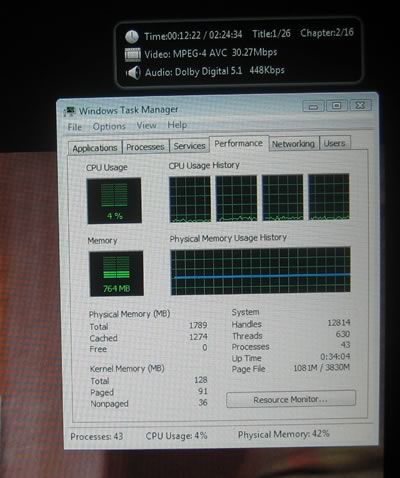
So the ATI HD3300 can easily deal with HD material.
Some remarks about the motherboard outputs:
- The DVI-D port does not support D-Sub connection with an adapter
- The HDMI audio output only supports AC3, DTS and 2-channel-LPCM
formats (AC3 and DTS require the use of an external decoder for decoding.)
- In case you decide to perform Dual display, only the [DVI-D + D-Sub] and [HDMI + D-Sub] are supported
16. Final words
 After so many benchmarks it's time to conclude all the test results. In general both tested motherboards gave a similar performance. The two AMD 790GX solutions differ in some features and in their retail price.
After so many benchmarks it's time to conclude all the test results. In general both tested motherboards gave a similar performance. The two AMD 790GX solutions differ in some features and in their retail price.
The Foxconn A7DA-S is cheaper and comes in a more "spartan" retail package, while the Gigabyte MA790GP-DS4H proved somewhat faster in tests especially under overclocking. It is possible that a newer BIOS for the Foxconn mainboard to improve its performance and behavior. For example, the Foxconn couldn't recognize the EPP profile of the OCZ PC2-8500 SLI memory and properly adjust the memory.
Besides the minor differences, we are happy that both motherboards identified the Phenom X4 9950BE CPU without any problems.

The ATI HD3300 comes with 128MB of GDDR3 on board giving us high expectations. The results were impressive either in games or video playback considering that we have to do with an IGP solution here. Before running the tests we couldn't expect to play Crysis at 800x600 even with low details. As for the Blu-Ray playback, the graphics engine showed us its strengths with the CPU utilization to be just 4~8% .

Concluding this roundup, we have nothing but a positive feeling about the AMD 790GX chipset. When paired with an AMD processor it offers good performance and most of all a very good IGP chipset that could be a very good companion for your new HTC PC. If we had to choose between the Gigabyte MA790GP-DS4H and Foxconn A7DA-S, our vote would go for the Foxconn A7DA-S since it has a lower retail price. We also liked the two on-board switches and hopefully the BIOS will get a fine tuning with a future update.

